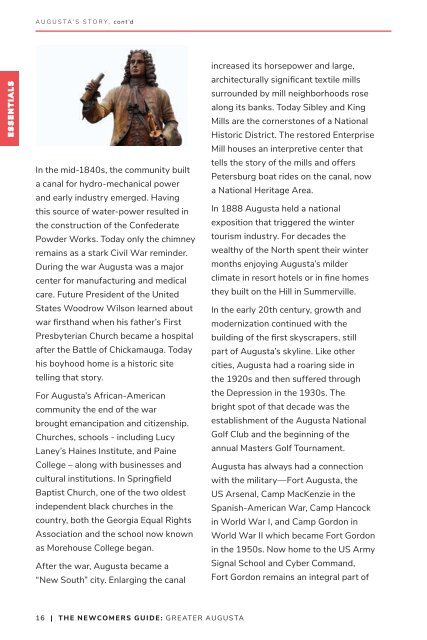Create successful ePaper yourself
Turn your PDF publications into a flip-book with our unique Google optimized e-Paper software.
AUGUSTA’S STORY, cont’d<br />
ESSENTIALS<br />
In the mid-1840s, the community built<br />
a canal for hydro-mechanical power<br />
and early industry emerged. Having<br />
this source of water-power resulted in<br />
the construction of the Confederate<br />
Powder Works. Today only the chimney<br />
remains as a stark Civil War reminder.<br />
During the war Augusta was a major<br />
center for manufacturing and medical<br />
care. Future President of the United<br />
States Woodrow Wilson learned about<br />
war firsthand when his father’s First<br />
Presbyterian Church became a hospital<br />
after the Battle of Chickamauga. Today<br />
his boyhood home is a historic site<br />
telling that story.<br />
For Augusta’s African-American<br />
community the end of the war<br />
brought emancipation and citizenship.<br />
Churches, schools - including Lucy<br />
Laney’s Haines Institute, and Paine<br />
College – along with businesses and<br />
cultural institutions. In Springfield<br />
Baptist Church, one of the two oldest<br />
independent black churches in the<br />
country, both the Georgia Equal Rights<br />
Association and the school now known<br />
as Morehouse College began.<br />
After the war, Augusta became a<br />
“New South” city. Enlarging the canal<br />
increased its horsepower and large,<br />
architecturally significant textile mills<br />
surrounded by mill neighborhoods rose<br />
along its banks. Today Sibley and King<br />
Mills are the cornerstones of a National<br />
Historic District. The restored Enterprise<br />
Mill houses an interpretive center that<br />
tells the story of the mills and offers<br />
Petersburg boat rides on the canal, now<br />
a National Heritage Area.<br />
In 1888 Augusta held a national<br />
exposition that triggered the winter<br />
tourism industry. For decades the<br />
wealthy of the North spent their winter<br />
months enjoying Augusta’s milder<br />
climate in resort hotels or in fine homes<br />
they built on the Hill in Summerville.<br />
In the early 20th century, growth and<br />
modernization continued with the<br />
building of the first skyscrapers, still<br />
part of Augusta’s skyline. Like other<br />
cities, Augusta had a roaring side in<br />
the 1920s and then suffered through<br />
the Depression in the 1930s. The<br />
bright spot of that decade was the<br />
establishment of the Augusta National<br />
Golf Club and the beginning of the<br />
annual Masters Golf Tournament.<br />
Augusta has always had a connection<br />
with the military—Fort Augusta, the<br />
US Arsenal, Camp MacKenzie in the<br />
Spanish-American War, Camp Hancock<br />
in World War I, and Camp Gordon in<br />
World War II which became Fort Gordon<br />
in the 1950s. Now home to the US Army<br />
Signal School and Cyber Command,<br />
Fort Gordon remains an integral part of<br />
16 | THE NEWCOMERS GUIDE: GREATER AUGUSTA



